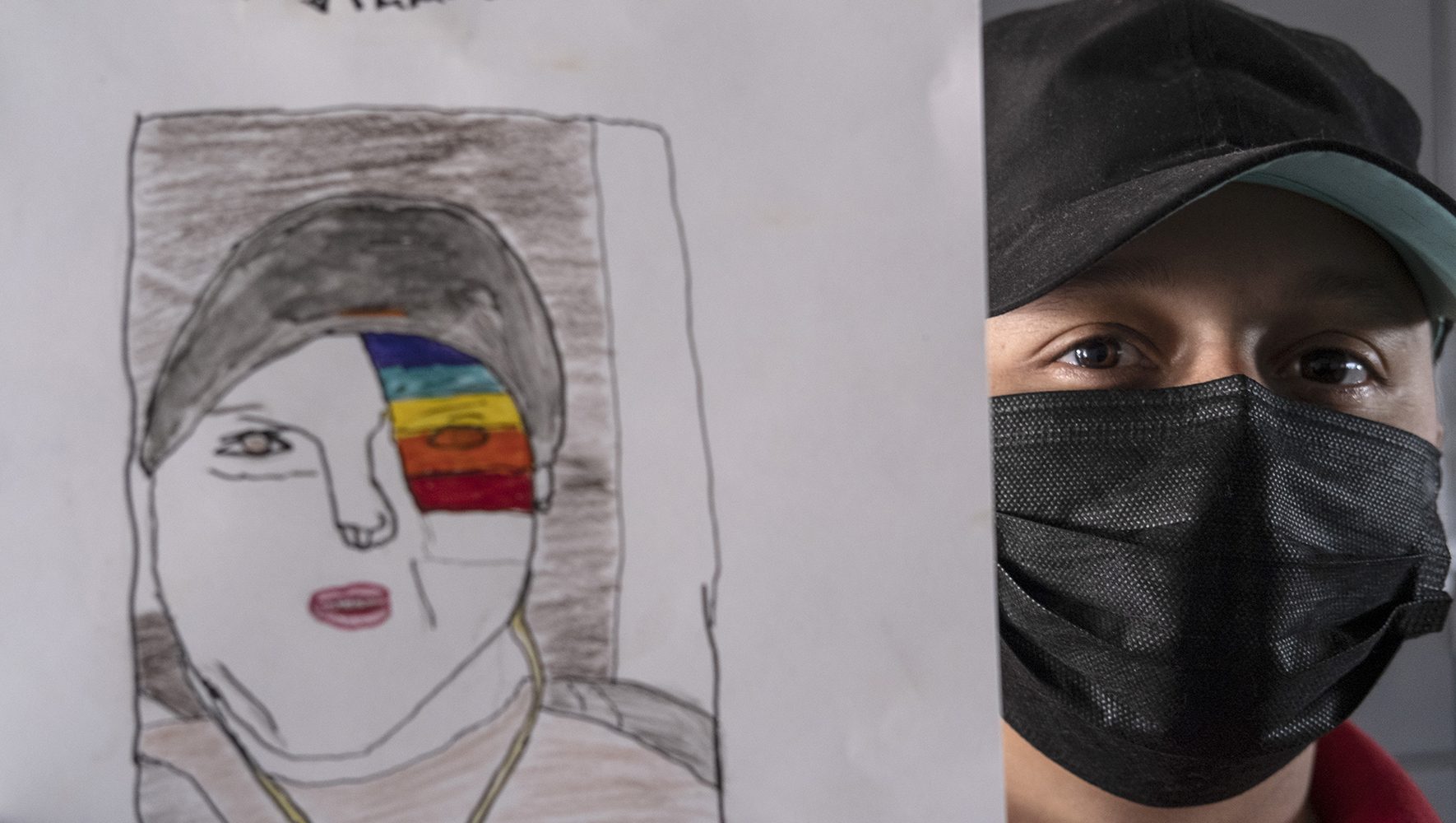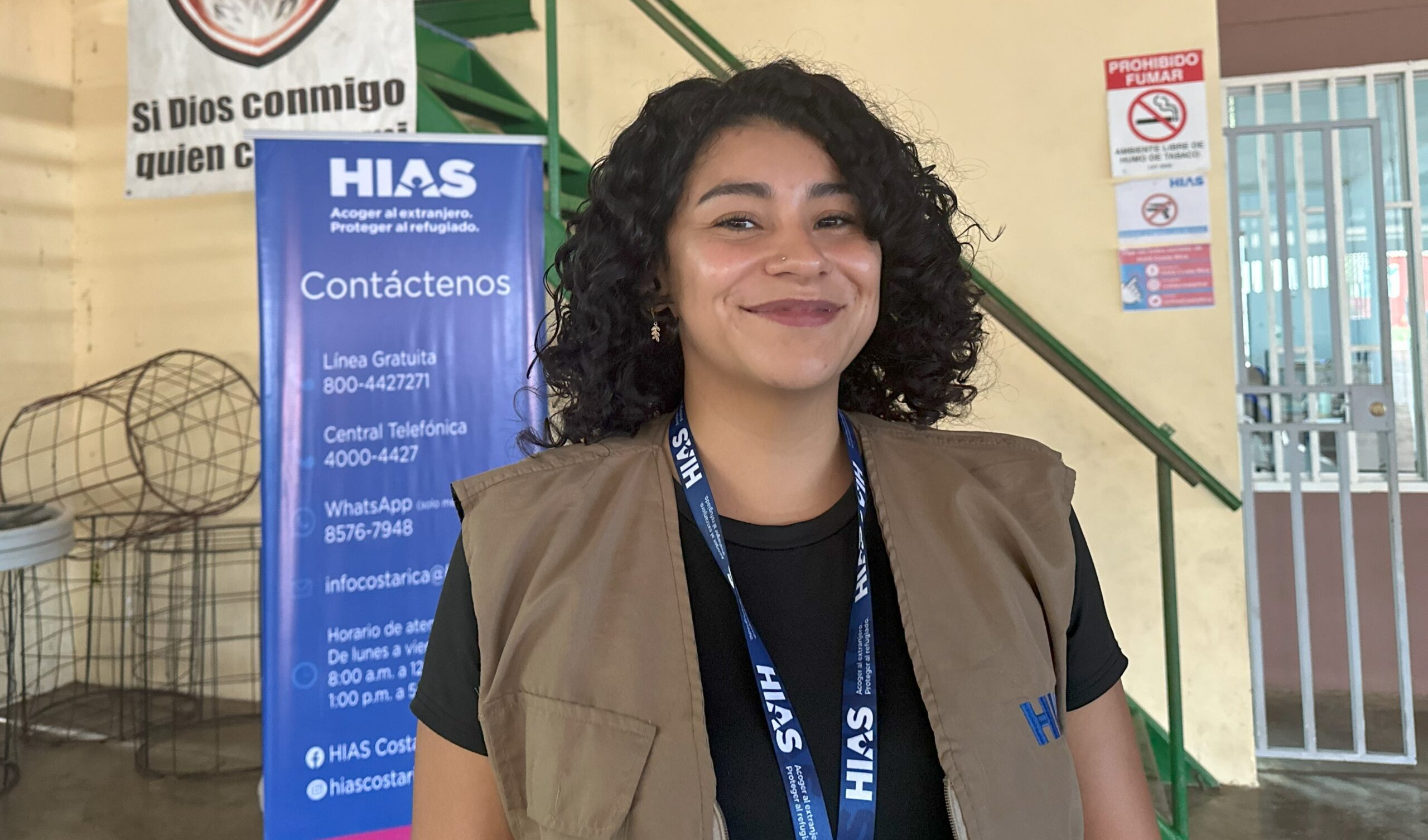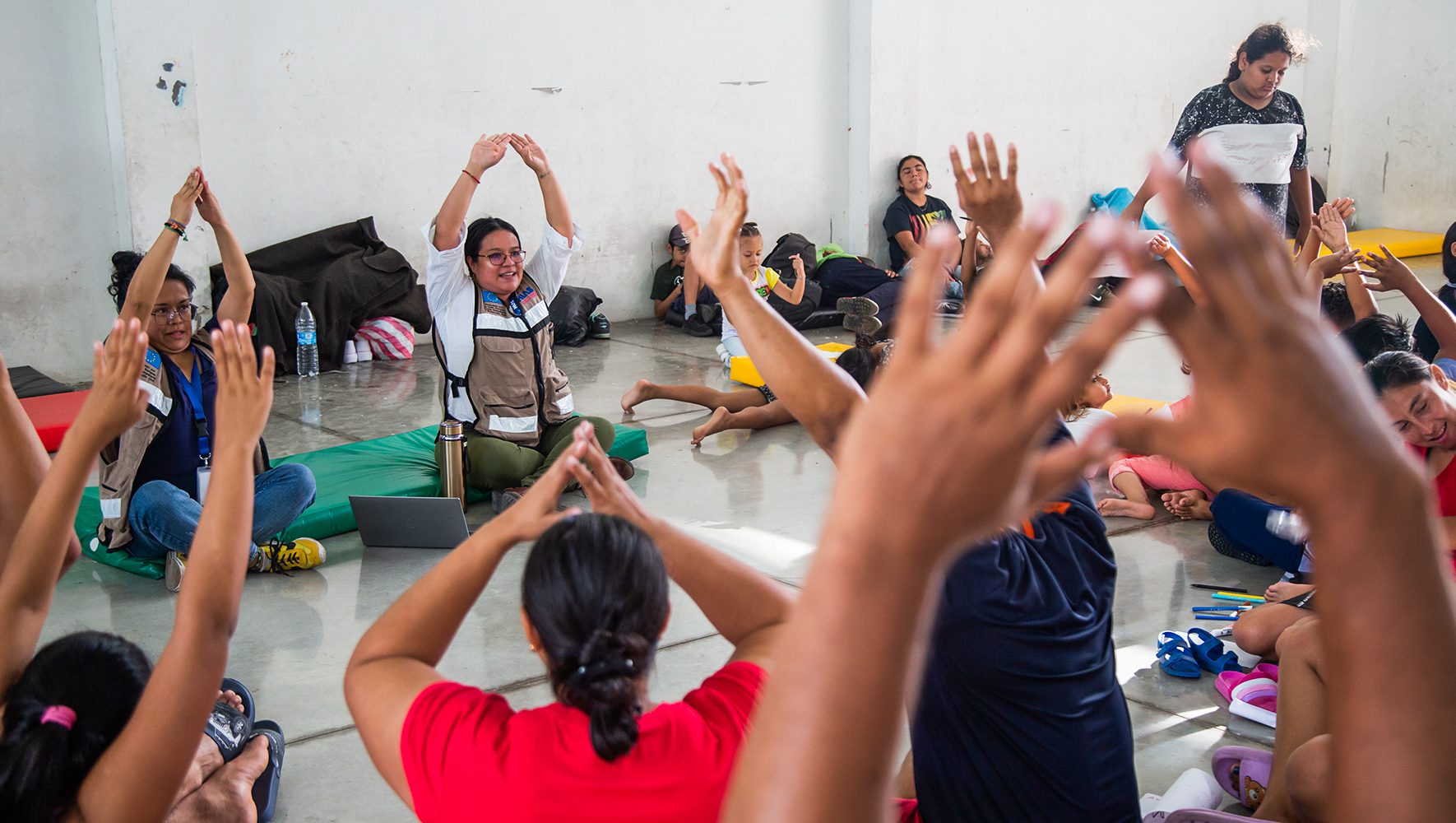The Unique Challenges Facing LGBTQ Refugees
By Matt Schiavenza
Managing Editor, HIAS
Aug 3, 2023

Nohelia Fiallos, a 28-year-old LGBTQ+ community member from Honduras, shows a painting she made during a HIAS dynamic at the Casa Arcoiris migrant shelter in Tijuana, Baja California state, Mexico, on February 9, 2022. (Guillermo Arias for HIAS)
In addition to the challenges shared by all displaced people, LGBTQ refugees encounter a unique set of difficulties that include stigmatization, isolation, and persecution. For years, HIAS has implemented programs designed to meet the particular needs of displaced LGBTQ people around the world.
Heidi Lehmann, who serves as senior advisor of business development for gender and gender-based violence at HIAS, has extensive experience working on programs that serve LGBTQ refugees. In this conversation, she discusses HIAS’ approach to LGBTQ beneficiaries and how her experience renting a room to a gay Syrian refugee brought the unique challenges facing this population into special focus.
What are the unique challenges faced by LGBTQ refugees and other displaced people?
To begin with, there are 66 countries around the world that criminalize same-sex relationships, so the persecution, violence, and oppression LGBTQ people face can certainly be a driver for displacement. But people are driven by more than just a desire not to face violence and oppression — they also wish to express themselves in an open, authentic way. On top of that, when you look at situations that cause mass displacement, there’s simply a percentage of those folks who are of diverse sexual orientation and gender identities.
Displaced LGBTQ people also experience oppression and discrimination in secondary countries, and it’s not always predictable when it’s going to show up. Is it at the doctor’s office? The benefits office? A job interview? You just don’t know — and so the toll this takes on LGBTQ people is often underestimated.
Where does HIAS work with LGBTQ refugees?
HIAS was an early adopter in prioritizing the needs of this population. If you’ve looked at our work in Kenya, which goes back years, we’ve been one of the primary supporters of LGBTQ refugees there. Back in 2014, we published a report called Triple Jeopardy that looked at the impact of displacement on sexual minorities. I think that showed that HIAS was committed not only to supporting LGBTQ refugees and asylum seekers but also were doing the research to understand the kind of support they needed and were looking for.
We’re active all over, and our services are built to meet the specific needs of the LGBTQ community in each location. In Greece, for example, we’re involved in strategic litigation to ensure that, say, trans women can get the documents they need to accurately represent who they are. We do extensive programming with LGBTQ refugees across Latin America and the Caribbean. Our programs make sure that when folks walk through the door, they don’t have to disclose their sexual orientation to us if they don’t want to, but that they know they’re safe if they choose to do so. We do this by providing signs that they see in our offices, and through verbal indications such as asking about pronouns. We do extensive training with our staff to reflect on their own assumptions and how these play into making our offices more inclusive.
HIAS has also taken a step back and realized that we cannot deal with the LGBTQ community as if it’s a monolith. We have to understand the particular needs of groups that fall under the LGBTQ umbrella. This requires having a robust research agenda. One of the things we’re looking at, for example, is the impact of displacement on lesbian parents. We work in a lot of countries where it can be hard for women to travel on their own and make all their own choices. So when there’s a custody issue, it can be hard for a woman who identifies as a lesbian to seek safety elsewhere with her children. This can block her right to seek asylum. And it’s something that’s not always on the radar of other humanitarian organizations.
"HIAS has also taken a step back and realized that we cannot deal with the LGBTQ community as if it’s a monolith."
Heidi Lehmann
What really typifies the impact of our work with LGBTQ populations?
One thing that comes to mind is our mental health and psychosocial support (MHPSS) programs. We’ve blended our approach to MHPSS and to economic inclusion so that LGBTQ people who come to us can seek mental health support and find a sustainable livelihood. Not every organization does this work. This is happening in three or four countries. In Ecuador, for example, we have an economic inclusion program that serves the entire LGBTQ community but places a particular focus on trans women.
We understand that it’s never just one challenge that they’re facing — and it’s not going to be just one solution that helps them. When people internalize the oppression and violence they face on a daily basis, that can easily turn into shame and self-loathing coupled with the trauma of displacement.
We should also be proud of our work in Kenya. Same-sex relationships are criminalized there. And yet it’s the only country in the region that accepts asylum seekers who flee because of their sexual orientation. Uganda, a neighboring country, just came out with hardcore anti-gay legislation, something that has driven a lot of displacement to Kenya. Our team at HIAS Kenya has done a great job helping Ugandans meet every aspect of their needs — whether it’s counseling, how to make a living, or getting access to safe housing. I think HIAS should feel very proud that we have staff there doing these things, because it can’t be easy in such a conservative environment.
We try to facilitate conversations and relationship building with LGBTQ groups, or in the communities where people are settling or seeking refuge. This helps some of the isolation, the loneliness that displaced LGBTQ people may face, to be broken. We have peer support networks which bring people together. It sounds really easy when I say it, but it’s not. For instance, getting on a bus as a trans woman in Nairobi to go to a peer support network… a lot of things can go wrong there. So HIAS makes sure that we provide safe transportation to wherever we’re doing these meetings, and we check and double check that where they’re going is going to be a friendly environment.
You recently hosted a refugee, Adam from Syria, in your home for some time. What was that like?
I saw an ad, I believe on Facebook, from a gay man from Syria who was looking for housing. My first thought was, man, he must have been through hell and back. It was a hard time for Syrians to get into the United States — especially if you were a single Syrian man. So I was curious how he was able to get in. Anyway, I invited him to come take a look at a spare room I had. He felt a very urgent need to get out of his living situation, and I don’t think his caseworker knew how to help him connect to LGBTQ resources.
In the end, he stayed with me for 18 months. He now lives with a different family and has become a U.S. citizen. He was even able to travel to Turkey to visit his sister, who is displaced in Gaziantep.
By coincidence, I was doing some consulting work that sent me to Gaziantep around that time. I put out an ask to my friends, and within two days I had some money and a giant duffle bag full of stuff to bring with me for Adam’s sister. The majority of the folks who contributed happened to be Jewish. When I told Adam this, he was very surprised — not only because they were strangers, but just that anyone would want to help him. And not only did they help him, but it came together in 48 hours.
“The people who are helping you believe you matter,” I told him. “Whether you are a stranger to them or not, you matter.”
The work that HIAS does with LGBTQ refugees and asylum seekers is personal for me. As a lesbian, my lived reality has included homophobia and violence. The idea of facing that while fleeing for my life, without support, is almost unimaginable. At HIAS, we do everything possible to make sure that support is there.
Related News
"Now I am Free": A Gay Ugandan Builds Community in the U.S.






